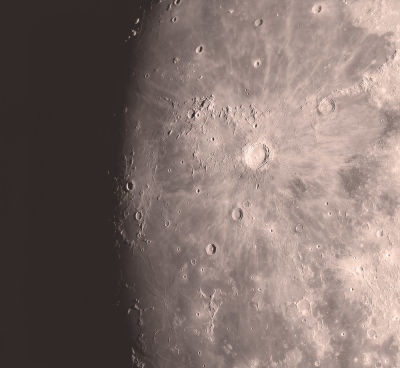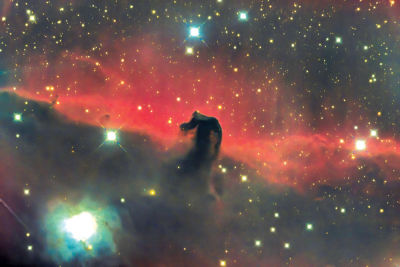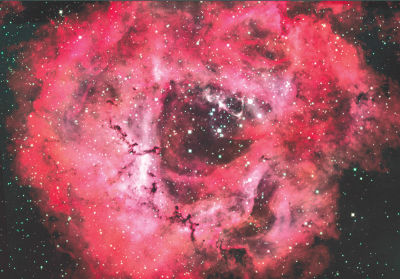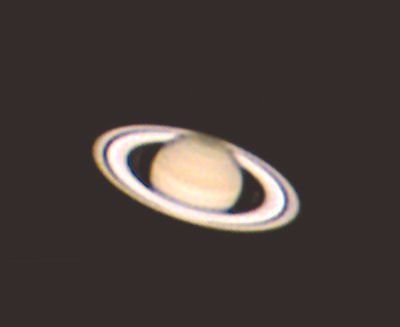
The lunar crater Copernicus is easily visible in almost any size of telescope.
Photo by Dana Tousley

The Horsehead Nebula is a small, dark nebula in the constellation Orion. This image was taken at the backyard observatory of Warren Astronomical Society member Doug Beck, near Fenton, in January.
Photo by Doug Beck

Pictured is the Rosette Nebula in the constellation Monoceros. This is a large emission nebula that is actually easier to see with binoculars from a very dark location than with a telescope because it is so large.
Photo by Bob Berta, of the Warren Astronomical Society

The planet Saturn is pictured in a photo taken by Bill Beers, of the Warren Astronomical Society, through an 11-inch telescope at his cabin west of Cadillac. You could fit 764 Earths inside of Saturn.
Photo by Bill Beers
METRO DETROIT — Whether it’s a distant planet aglow amid clusters of stars, meteors streaking across the sky or a couple of familiar constellations, you see a lot by simply looking up.
As the spring equinox March 20 marks the sun’s passage across the celestial equator, Dana Tousley, of the Oakland Astronomy Club, a stargazer for over 10 years, has some tips to take your stargazing to the next level. The first is that it’s important to remember the basics.
Nothing affects our ability to view the night sky more than the weather, so a cloudless, dark sky is key. Tousley relies on the website ClearDarkSky.com to help determine the best nights for an intimate look above.
“Here in Michigan, you take every noncloudy night as a gift,” he said.
The next step, according to Bob Trembley, the outreach officer for the Warren Astronomical Society, is finding the right location.
“Around 80% of the human population on this planet live in an urban environment, and they cannot see the sky. You can see maybe 12 stars — that’s it,” Trembley explained. “When you’re in a dark sky environment and you see the sky for the first time, I’ve seen people completely blown away by it. That’s one of the amazing things about it.”
The farther away you get from city lights, the more you’re going to be able to see, Tousley said.
“Addison Oaks (County Park) is a fairly dark location for Oakland County, but … if you get up into the Thumb, you’ll find that things are many times better than around here. It’s all because of the light pollution from the cities,” he said.
The best time to look at the sky is around “astronomical twilight,” the earliest stage of dawn in the morning and the last stage of dusk in the evening.
“It’s about an hour or so after sunset, because when the sun sets, you still can’t see any stars — the first things you will see are Venus and Jupiter — and the sun has to be significantly down below the horizon for it to be completely dark,” Tousley explained.
A pair of binoculars and a star chart — a diagram of where constellations are — are the best tools for beginner stargazers to invest in.
Leave the flashlights at home, Tousley said, unless they are specialized red flashlights.
“Any sort of light source will ruin your night vision for at least a half an hour,” he explained. “If you look at your cellphone, that’s a bright blue light. Your pupils contract and your retinas actually chemically change in effect of bright light, so it can take about a half-hour for most people’s eyes to adjust to the dark. Once that happens, you’ll be able to see more in a telescope or binoculars, or even just looking around.”
Before buying a telescope, Trembley encourages the public to connect with their local astronomy clubs, which often have members with astronomy equipment they are happy to share at stargazing events.
“I’ve had so many people use my telescope, and it’s the first time they’ve ever looked through a telescope — which I just find sad — and the reaction is universal: ‘Oh my God,’” he said. “Astronomy makes an impression on people. And sometimes, it’s a deep impression on people.”
You will see different things in the sky depending on the season.
“In the springtime, you’ll typically be able to find galaxies. In the summertime, the Milky Way is a little higher, so there are a lot of globular clusters and a few nebulae. In the fall, there’s different constellations, and then in the winter, there’s Orion and the Pleiades and other things like that that are interesting to look at,” Tousley said.
Whether you’re an experienced stargazer, a newbie, or you just need help learning your telescope, you’re sure to find somebody to talk to at one of the local amateur astronomers clubs.
The Oakland Astronomy Club, which has about 30 members, meets at 7 p.m. the second Sunday of every month at the Dinosaur Hill Nature Preserve, 333 N. Hill Circle in Rochester. The club also operates an observing site — which is home to the club’s 17.5-inch f/4.5 reflecting telescope — at Addison Oaks County Park, on West Romeo Road in Leonard. The site is normally open to the public twice a month, when the moon phase is conducive to deep sky observing, and those interested can check www.oaklandastronomy.net for upcoming observing nights and call the contact person listed online for more info.
The Warren Astronomical Society meets twice monthly indoors for presentations about astronomy — observations, science, culture and history — at 7:30 p.m. the first Monday of the month at the Cranbrook Institute of Science in Bloomfield Hills, and at 7:30 p.m. the third Thursday of the month at Macomb Community College in Warren. The society also meets at least once a month — typically at dusk on the fourth Saturday of the month — under the stars for observing at the Stargate Observatory, 20505 29 Mile Road in Ray Township.
For more information, visit www.warrenastro.org.




